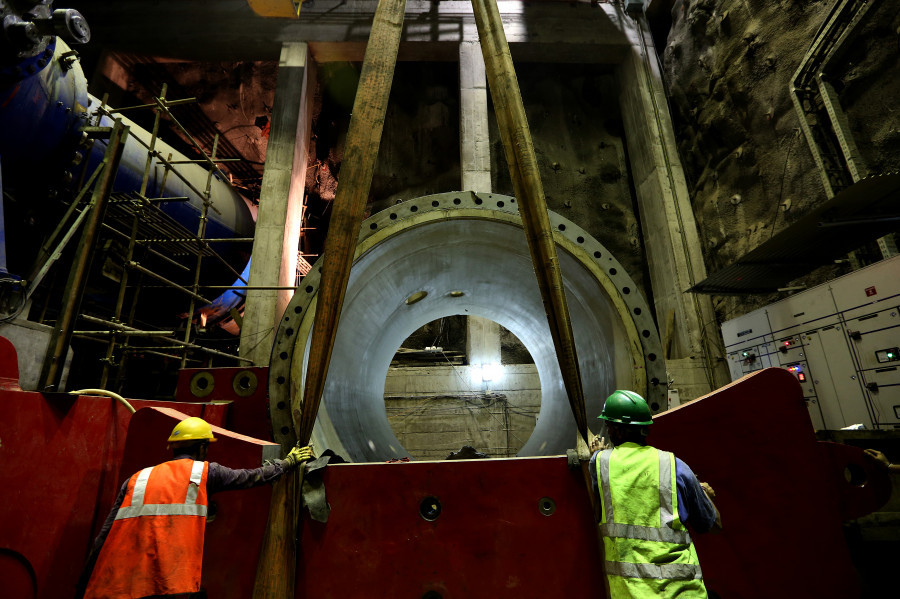Money
Workers finish installing penstock shaft at Upper Tamakoshi project
The 456 megawatt plant is likely to begin production in October, making Nepal an energy surplus country.
Post Report
The construction of the long-delayed Upper Tamakoshi Hydropower Project moved a step closer to completion after crews installed a 305-metre-long upper penstock shaft on Sunday, a very challenging and risky task.
The lower penstock shaft, which is 367 metres long, was installed in May.
Construction work on the 456 megawatt project located on the Tamakoshi River in Dolakha district in north central Nepal began in 2012. It will be the largest hydropower plant in the country when it is completed.
Upper Tamakoshi is expected to begin production in October, making Nepal a power surplus country capable of exporting electricity.
“We still have to install the horizontal penstock shaft, but that’s not a challenging task. Then there are the finishing touches like commissioning and testing the project,” said Bigyan Prasad Shrestha, chief executive officer of the project.
The challenge now is to bring technicians for commissioning and testing the project from abroad as many parts of the world are still under lockdown, he said. “We assume that international flights will resume by September.”
Shrestha said that the riskiest and most challenging work had been completed. The plant was expected to come into operation by mid-June, but the Covid-19 pandemic pushed back its operation deadline.
Project officials said that workers faced rock fall hazards, and there was the difficulty of removing the fumes produced during welding. “But all tasks were completed without mishap,” Shrestha said.
According to the revised deadline, the national pride project plans to bring the first unit into operation by October-end, adding 76 megawatts of electricity to the national grid. The project has a total of six turbines. The other five units will start generating electricity within five months of the first unit being switched on.
The energy produced by the project will be transmitted to a substation at Khimti via the 220 kV Gongar-Khimti transmission line which is currently under construction. The power evacuated to the Khimti substation will be transmitted to Kathmandu Valley and other energy-hungry neighbouring cities.
Initially, the project had aimed to start generating electricity by mid-November 2019, but the deadline had to be pushed back due to the poor work executed by the hydro-mechanical contractor, Texamo Railway Engineering. The installation of the penstock pipes had been slated for 2015.
Construction work stopped for months because Texamo lacked the expertise to execute the difficult task of installing the penstock pipes. Subsequently, the project developer, Upper Tamakoshi Hydropower Limited, appointed another contractor to fit the high pressure steel penstock pipes when the Indian firm abandoned the project after completing more than 95 percent of the construction work.
As delays in the execution of the hydro-mechanical component threatened to push back the completion date of the project which was already running late, the project developer asked the Indian contractor to reassign the crucial task of installing the penstock pipes to Austrian firm Andritz Hydro.
In January last year, Upper Tamakoshi Hydropower Limited, Texamo and Andritz signed a tripartite agreement under which the Indian firm subcontracted the task of installing the penstock pipes to the Austrian company. Immediately after signing the pact, Andritz mobilised workers at the project site and construction work resumed.
The project has encountered massive cost and time overruns. Its price tag has swelled to Rs49 billion, excluding interest on loans, from the initial cost estimate of Rs35 billion.
Interest payments on long-term loans alone have jumped from Rs6.7 billion in 2016 to Rs14.42 billion in two years. The annual interest rate has been set at 11 percent. As of date, the total project cost including interest on loans has been estimated at Rs73 billion.
The Upper Tamakoshi Hydroelectric Project is touted to be of high economic importance to Nepal as it will not only make it an energy surplus country, but also cut the import of electricity from India in the dry season, thus saving billions.




 11.12°C Kathmandu
11.12°C Kathmandu













